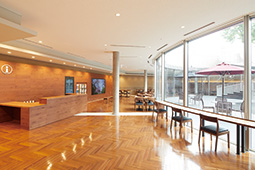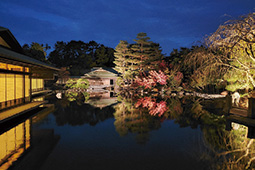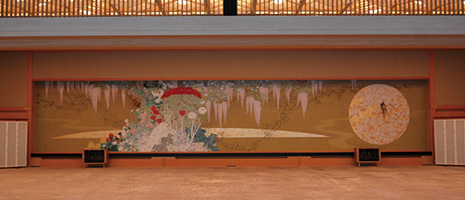INDEX

The tourist lounge in the park in front of the State Guest House, Akasaka Palace 
The Kyoto State Guest House illuminated in 2019 during a period of extended opening hours 
Kiri no Ma in the Kyoto State Guest House
September 2020
The Public Opening of the State Guest Houses

The two State Guest Houses, located in Tokyo and Kyoto, are national facilities to welcome monarchs, presidents, prime ministers and other dignitaries with the best hospitality. Both Guest Houses are open to the general public, as long as their primary activities of welcoming dignitaries are not interrupted, and visitors can enter into the interior of the buildings and see the interior decorations and furniture integrating the best essence of Japanese architecture, art, craftsmanship and more.

State Guest House, Akasaka Palace
The State Guest House, Akasaka Palace, located not far from Yotsuya Station in Tokyo, was originally built as the Togu Gosho (Crown Prince’s Residence) in 1909. After the Second World War, various governmental organizations used the building, and it was opened as the State Guest House in 1974 after undergoing large-scale repairs. At that time, Yushintei, a Japanese-style annex, was newly built for tea ceremonies and other forms of Japanese-style hospitality. Since then, the State Guest House has been a place for state guests and other dignitaries to stay and a stage for diplomacy for summit meetings, the hosting of international conferences, and more. In 2009, the Main Building, front gate and other parts were designated as National Treasures.
In April 2016, the buildings began to be opened to the public year-round, with many tourists from within Japan and abroad coming to visit. Currently, the buildings are open with novel coronavirus disease (COVID-19) measures in place, such as temperature checks at the entrance, stationing of hand sanitizer dispensers, and ensuring of social distance between visitors.
The Main Building, with its two above ground floors and one basement floor, is 125 meters wide, 89 meters deep, and 23.2 meters tall. It is the only palace in Japan that was built in the Neo-Baroque style. There are four rooms set up to welcome guests.
Asahi no Ma, the most elegant room in the State Guest House and used as a salon for dignitaries, features a ceiling painting of Aurora, the Roman goddess of dawn, driving a chariot in front of the rising sun. A hand-woven dantsu carpet with cherry blossom designs is laid out on the floor.
The ash panel walls of Kacho no Ma, where banquets are held, are decorated with thirty cloisonné medallions depicting flowers of the four seasons and birds.
In Hagoromo no Ma, where dignitaries are ceremonially welcomed, three huge chandeliers—at 3 meters tall the largest of all those in the State Guest House—hang from the ceiling, which is painted with pictures based on the noh play Hagoromo (Robe of Heaven).
Used as a waiting room for guests, Sairan no Ma is decorated with golden reliefs of mythical ran birds, which symbolize peace. There are other highlights as well, including a large hall and the main garden with its fountain.
A tourist lounge (9 a.m. to 5 p.m., closed Wednesdays, free entry) was opened in June 2020 in the park in front of the State Guest House. In addition to rest areas set up both inside and outside, the tourist lounge features a multi-purpose toilet, café, gift shop, and a multi-screen display that plays films related to the State Guest House.
Access: 7-minute walk from Yotsuya Station on the JR and Tokyo Metro lines
Hours: 10 a.m. to 5 p.m. (usually closed on Wednesdays)
Admission Fees: Adult ¥1,500 (Main Building and gardens can be visited. Advanced reservations are required to visit the Japanese-style annex. The fee for the Main Building, Japanese-style annex, and gardens is ¥2,000)
URL: www.geihinkan.go.jp/en/akasaka
Kyoto State Guest House

The Kyoto State Guest House was opened in 2005 to welcome distinguished guests from abroad to Kyoto, the ancient capital boasting a long history and rich traditional culture. The building, located inside the Kyoto Gyoen National Garden, features an irimoya-style roof and a sukiya-style external appearance typical of Japanese traditional residences, in order to harmonize with its historic landscape and surrounding natural environment. The interior incorporates wood and washi paper in abundance creating a distinctively Japanese atmosphere. The concept for the interior is made up of “modern Japanese,” combining the essence and beauty of traditional Japanese architecture with modern architectural techniques, and the teioku-ichinyo philosophy, in which an exquisite harmony is achieved between a Japanese garden and its buildings.
The Kyoto State Guest House began to be opened to the public year-round from 2016. Currently, the Kyoto State Guest House is implementing thorough measures to prevent COVID-19 infection, and the buildings are opened to the public with advanced reservation only while guided tours are conducted with a limited number of guests.
At the Kyoto State Guest House, visitors can see many beautiful pieces of furniture made using traditional Japanese techniques. For example, when banquets and ministerial meetings are held, Juraku no Ma is used as a waiting room for dignitaries or accompanying staff. In the room, there are comfortable chairs, constructed without iron nails using the kyo-sashimono traditional joinery technique, covered in a vivid crimson upholstery, woven in Kyoto's Nishijin district.

In Fuji no Ma, used as a venue for banquets and ceremonial welcomes, a tapestry depicting thirty-nine varieties of flowers and woven in the tsuzure-ori technique brings splendor to the room.
A 12-meter-long deep black lacquer table is located at the center of Kiri no Ma, a Japanese-style room with tatami mats for banquets where authentic Kyoto cuisine is served, and guests of honor can gaze at the Japanese-style garden from where they are seated.
And from the open-air covered bridge that crosses the pond, visitors can see the shapes of many varicolored carp slowly swimming among the reflection of the building on the water’s surface.

Opening hours at the Kyoto State Guest House are extended until 7 p.m. for two days, from November 21 (Sat) through 22 (Sun), with guided tours for a small group of people starting at 4:30, 5:10, and 5:50 p.m. On these days, the building and gardens are illuminated and their daytime appearance is transformed. The soft, golden light filtering through the paper sliding doors of the Kyoto State Guest House is reflected in the pond making the building appear to float, and the colorful autumn leaves in the garden look more radiant than ever.
Access: 7-minute walk from the Kyoto City Bus Furitsu Idai Byoin-mae (Univ. Hospital, Kyoto Prefectural Univ. of Medicine) bus stop. 15-minute walk from Imadegawa Station on the Kyoto City Subway Karasuma Line. 20-minute walk from Demachi Yanagi Station on the Keihan Railway
Hours: 10 a.m. to 5 p.m.
Admission Fees: Adult ¥2,000 (For the time being, guided tours are conducted ten times a day. Each tour is for up to thirty people. Advanced reservations required)
URL: www.geihinkan.go.jp/en/kyoto/

